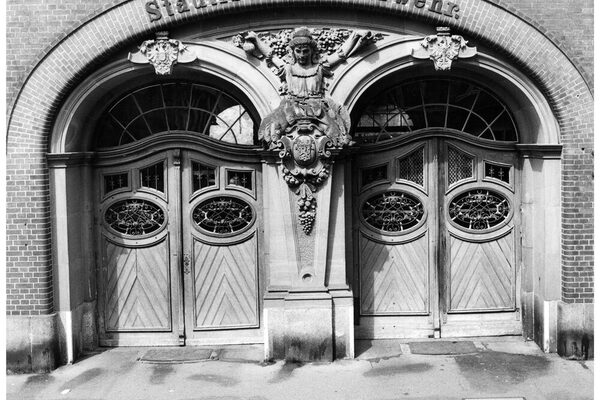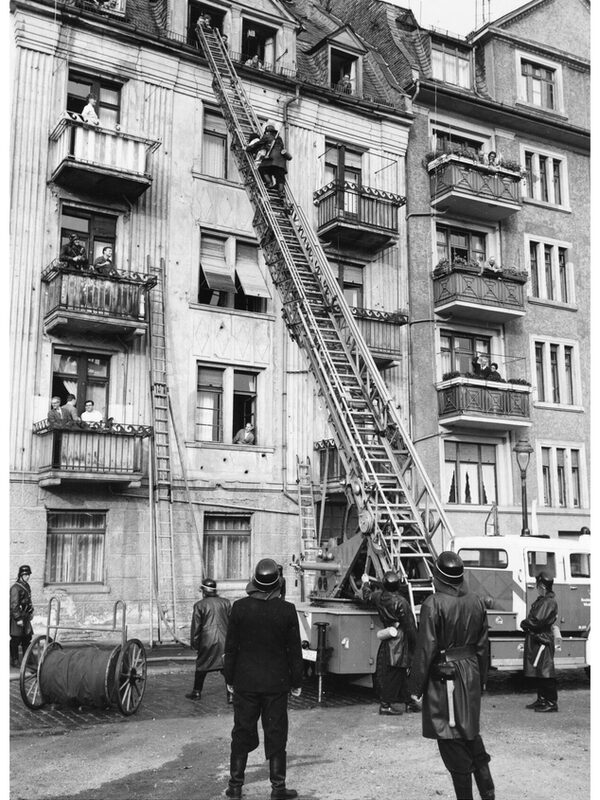Firefighting
Several devastating fires have been recorded in Wiesbaden in the 16th century. The often almost ineffective fire extinguishers consisted of leather and Stroheimers, fire pats and fire hooks. According to the fire regulations of the time, every citizen was obliged to "shout out" the fire when a fire broke out, i.e. the cry "Fire, fire" was to be passed on. The night watchmen had to keep an eye on what was happening in the city and blow the time every half hour as a sign of their vigilance. The Wiesbaden fire-fighting regulations (renewed) from July 21, 1692 are the oldest surviving document relating to fire-fighting. In 1707, Prince Georg August Samuel zu Nassau-Idstein declared the purchase of a fire engine to be absolutely necessary; this device is also documented for Wiesbaden in a fire report from 1765. Towards the end of the 17th century, the question of regulated compensation in the event of fire became increasingly urgent. The aim of German princes was to help the victims of fires by spreading the damage across many shoulders when they created "Brandassekuranzen". At that time, all citizens were obliged to provide fire-fighting services. In this way, "compulsory fire departments" were created. However, the service there was mostly performed carelessly and with reluctance. Compulsion and punishment did little to alleviate this situation.
It was not until the revolutionary year of 1848 that a fundamental change took place. The citizens took fire-fighting into their own hands and founded Wiesbaden's first voluntary fire department in 1850. In 1870, with the establishment of the general water supply in Wiesbaden, the fire department could also be supplied with water from pipes. 339 underground hydrants were distributed throughout the city for fire-fighting purposes. From 1888, the day watch was introduced, manned by the "shoemaker's fire department", who were able to carry out their trade on their own account during the watch period. The night watch was usually carried out by building tradesmen who worked in their profession during the day. In 1888, the first fire alarm system with a public fire alarm was installed in the old town hall. On October 2, 1901, the volunteer fire department moved into the new fire station in Neugasse.
In 1903, the professional fire department was founded, which also took over the transportation of injured persons for the time being. Four new vehicles (gas fire engine, universal fire engine, turntable ladder and steam fire engine - horse-drawn) were put into service in 1904. In 1909, the professional fire department had a staff of 65 men. In 1914, the first "automobile fire engine" was purchased. The motorization of the fire department was largely completed in the 1920s and horses were finally phased out in 1923. A volunteer fire department was also founded in the town of Biebrich in 1851. It was followed by all the suburbs between 1866 and 1935. With the incorporation, the management of the fire department of the municipalities concerned was also transferred into the hands of the municipal professional fire department. Only fire protection in Biebrich was provided by a "Schuster fire department" - as had already been the case in Wiesbaden in 1888. In 1938, the fire department was renamed the "Fire Police" and was now under "unified Reich management". The year 1939 marked the beginning of organized air raid protection. In the course of the Second World War, the accident and ambulance service was separated from the professional fire department in 1943 and handed over to the Red Cross. In 1945, Fire Station 2 in Biebrich was badly damaged by an air raid. In 1946, radio communication was introduced in the fire department and in 1956 the "preventive fire protection" department was set up to prevent fires. The new fire station at Kurt-Schuhmacher-Ring 16 was occupied in 1965.
For fire protection on the Rhine and Main rivers, the fire department set up a diving team of 14 officers in 1971; a fireboat has been available since 1989. The fire department's technical equipment was continuously expanded. In the mid-1970s, for example, the fire department had the first mobile command center at its disposal, which included a large tanker with a capacity of 6,000 liters of water and 1,000 liters of foaming agent.
Today, Wiesbaden has a professional fire department with around 280 officers (as of 2015), equipped and trained not only for firefighting but also for a wide range of emergency services. Of these, around 260 are on duty. Three fire stations are manned around the clock. Each district of Wiesbaden also has a volunteer fire department, with a total of around 600 firefighters. Around 120 emergency vehicles are stationed in the fire stations and equipment sheds. The fire chiefs were: Christian Zollmann (1861-1871), Hermann Scheurer (1871-1905), Johann Stahl (1903-1920), Emil Diel (1920-1945 and again 1950-1953), Felix Rauschning (1945-1947), Albert Noehl (1947-1950), Kurt Möbius (1953-1968), Franz-Anton Schneider (1968-1979), Willi Döbbemann (1979-1995), Harald Hagen (1995-2012), Harald Müller (since 2012).
Literature
Sack, Georg: The Wiesbaden fire department past and present. 100 Jahre Berufsfeuerwehr Wiesbaden 1903-2003, 2nd revised edition, Mainz-Kastel 2003.

